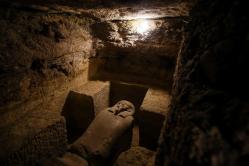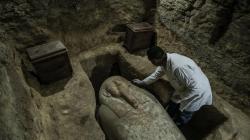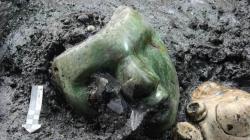ONLINE COURSES / COURS A DISTANCE
WINTER TERM : APRIL 2020
REGISTER NOW
ROYAUME UNI –  Jersey - Two men who found a huge hoard of pre-Christian coins in a field in Jersey have been recognised as record-setters. The Celtic coins were discovered by metal detectorists Reg Mead and Richard Miles in 2012. The number of coins has been verified as 69,347 - breaking the record for the largest collection of Iron Age coins. Mr Miles said he and Mr Mead had been "involved the whole way through" and it was "lovely" receiving the official Guinness World Records certificates. The hoard, thought to date from about 50BC, was discovered at a depth of just over 3ft (1m).
Jersey - Two men who found a huge hoard of pre-Christian coins in a field in Jersey have been recognised as record-setters. The Celtic coins were discovered by metal detectorists Reg Mead and Richard Miles in 2012. The number of coins has been verified as 69,347 - breaking the record for the largest collection of Iron Age coins. Mr Miles said he and Mr Mead had been "involved the whole way through" and it was "lovely" receiving the official Guinness World Records certificates. The hoard, thought to date from about 50BC, was discovered at a depth of just over 3ft (1m).
https://www.bbc.com/news/world-europe-jersey-51327021
EGYPTE – 

 Al-Ghoreifa - A vast trove of artifacts, including 20 sarcophagi, has been discovered in sixteen tombs in Egypt’s Minya region. It’s the latest in a series of high-profile digs which have resulted in extraordinary finds in recent years. The Ministry of Antiquities unveiled the incredible discovery at the Al-Ghoreifa site, about 300 kilometres (186 miles) south of Cairo on Thursday. The tombs contained the mummified bodies of high priests of the god Djehuty, and nobility from the 26th dynasty from the Late Period around 3,000 years ago. A spectacular sarcophagus inscribed with hieroglyphics dedicated to the sky god Horus was also unearthed. Speaking at a presentation at the site, the Egyptian Minister of Antiquities Khaled El-Enany said the Minya region ‘continues to reveal its secrets’ as he showcased some 10,000 blue and green ushabti (funerary figurines) and 700 amulets, including some made of pure gold. Two of the sarcophagi were still sealed and in ‘very good’ condition, according to Mohamed Wahballah, a member of the archaeological team. Amulets marked with scarab shapes and images of a winged cobra were also discovered. Painted limestone canopic jars used to store the organs of those mummified and buried in the tombs were also unveiled at the ceremony.
Al-Ghoreifa - A vast trove of artifacts, including 20 sarcophagi, has been discovered in sixteen tombs in Egypt’s Minya region. It’s the latest in a series of high-profile digs which have resulted in extraordinary finds in recent years. The Ministry of Antiquities unveiled the incredible discovery at the Al-Ghoreifa site, about 300 kilometres (186 miles) south of Cairo on Thursday. The tombs contained the mummified bodies of high priests of the god Djehuty, and nobility from the 26th dynasty from the Late Period around 3,000 years ago. A spectacular sarcophagus inscribed with hieroglyphics dedicated to the sky god Horus was also unearthed. Speaking at a presentation at the site, the Egyptian Minister of Antiquities Khaled El-Enany said the Minya region ‘continues to reveal its secrets’ as he showcased some 10,000 blue and green ushabti (funerary figurines) and 700 amulets, including some made of pure gold. Two of the sarcophagi were still sealed and in ‘very good’ condition, according to Mohamed Wahballah, a member of the archaeological team. Amulets marked with scarab shapes and images of a winged cobra were also discovered. Painted limestone canopic jars used to store the organs of those mummified and buried in the tombs were also unveiled at the ceremony.
https://www.rt.com/news/479729-egypt-unveils-3000yo-tomb-minya/
AFRIQUE –  - A new study indicates that modern Africans inherited DNA from migrating Neanderthals. Geneticist Joshua Akey of Princeton University and his colleagues conducted a statistical analysis of DNA gathered from 2,504 modern Africans, Europeans, and East Asians, and compared it with records of DNA extracted from Neanderthal remains in Siberia and southeastern Europe. They concluded that modern Africans, on average, indirectly inherited as much as 0.5 percent of their genome from Neanderthals. The Neanderthal gene variants, which may have acted to strengthen the immune system and modify sensitivity to ultraviolet radiation, are thought to have been carried to Africa by a human population that left the continent between 100,000 and 150,000 years ago, interbred with Neanderthals outside of Africa, and then returned. “Our work highlights how humans and Neanderthals interacted for hundreds of thousands of years, with populations dispersing out of and back into Africa,” Akey said. “Remnants of Neanderthal DNA survive in every modern human population studied to date.”
- A new study indicates that modern Africans inherited DNA from migrating Neanderthals. Geneticist Joshua Akey of Princeton University and his colleagues conducted a statistical analysis of DNA gathered from 2,504 modern Africans, Europeans, and East Asians, and compared it with records of DNA extracted from Neanderthal remains in Siberia and southeastern Europe. They concluded that modern Africans, on average, indirectly inherited as much as 0.5 percent of their genome from Neanderthals. The Neanderthal gene variants, which may have acted to strengthen the immune system and modify sensitivity to ultraviolet radiation, are thought to have been carried to Africa by a human population that left the continent between 100,000 and 150,000 years ago, interbred with Neanderthals outside of Africa, and then returned. “Our work highlights how humans and Neanderthals interacted for hundreds of thousands of years, with populations dispersing out of and back into Africa,” Akey said. “Remnants of Neanderthal DNA survive in every modern human population studied to date.”
https://www.sciencenews.org/article/new-genetic-analysis-reveals-modern-africans-have-some-neandertal-dna
ROYAUME UNI –  Jersey - A group of archaeologists will carry out a survey of a former Ice Age landscape in Jersey to understand more about its history. The Violet Bank, which sits 4.5km off the island's south west coast, is a section of granite reef which contains former land surfaces in its gullies. The team of experts hopes the survey will help them explore how Neanderthal people and other early humans used the landscape and how it matches up with discoveries made on land. They hope it will also set the groundwork for wider surveys which would allow them to identify artifacts and items of interest before they become inaccessible due to rising sea levels. Dr Matt Pope, who is leading the project, says there are plenty of artefacts to be uncovered. The researchers will carry out the work in four-hour excursions, starting at Seymour Tower. They have already carried out excavations at La Cotte at Ouaisné, which is the largest known neanderthal Ice Age site in Europe.
Jersey - A group of archaeologists will carry out a survey of a former Ice Age landscape in Jersey to understand more about its history. The Violet Bank, which sits 4.5km off the island's south west coast, is a section of granite reef which contains former land surfaces in its gullies. The team of experts hopes the survey will help them explore how Neanderthal people and other early humans used the landscape and how it matches up with discoveries made on land. They hope it will also set the groundwork for wider surveys which would allow them to identify artifacts and items of interest before they become inaccessible due to rising sea levels. Dr Matt Pope, who is leading the project, says there are plenty of artefacts to be uncovered. The researchers will carry out the work in four-hour excursions, starting at Seymour Tower. They have already carried out excavations at La Cotte at Ouaisné, which is the largest known neanderthal Ice Age site in Europe.
https://www.itv.com/news/channel/2020-01-31/archaeologists-to-explore-ice-age-landscape-off-jersey-coast/
MEXIQUE –  Teotihuacan - As the largest building in Teotihuacan, archaeologists have been continuously studying the structure, which was built around 100 CE. Though few artifacts have been found on-site, in 2011 a surprising discovery was made by researchers from Mexico’s National Institute of Anthropology and History (INAH). By using a 380-foot-long tunnel dug by archeologists in the 1930s, the group was able to get to the mother-rock level. Once there, they discovered a rare cache of treasures. This included shards of clay pottery, animal bones, pieces of obsidian, three serpentine human figurines, and a stunning serpentine mask. The green mask is particularly interesting because, at the time of its discovery, it was the only mask of its kind to be found in a ritual context in Teotihuacan.It’s believed that these offerings were left as part of a ritual to inaugurate the construction of the pyramid—hence its location at the lower level. The mask itself is extremely lifelike, which gave rise to the theory that it’s actually a portrait. This would be incredible, as archeologists have little information about the people who constructed Teotihuacan. There are also conflicting theories about the exact use of the pyramid. Even the name isn’t original. It was actually the Aztecs, who visited Teotihuacan centuries after it was abandoned, that named it Pyramid of the Sun. The original name of the world’s third-largest pyramid remains unknown. Teotihuacan was a thriving city once called the City of the Gods. At its peak, 200,000 people called it home. And yet, researchers have little to no idea who these dominant people were and why these vanished without a trace. With so much information to discover, it’s not a surprise that INAH continues to conduct research in the area. In fact, more recently, an underground tunnel was found under the nearby Pyramid of the Moon. By using electrical resistance technology, they were able to map the tunnel without breaking ground.The subterranean chamber, which is proceeded by a chamber measuring 49 feet in diameter, could be the home of even more treasures.
Teotihuacan - As the largest building in Teotihuacan, archaeologists have been continuously studying the structure, which was built around 100 CE. Though few artifacts have been found on-site, in 2011 a surprising discovery was made by researchers from Mexico’s National Institute of Anthropology and History (INAH). By using a 380-foot-long tunnel dug by archeologists in the 1930s, the group was able to get to the mother-rock level. Once there, they discovered a rare cache of treasures. This included shards of clay pottery, animal bones, pieces of obsidian, three serpentine human figurines, and a stunning serpentine mask. The green mask is particularly interesting because, at the time of its discovery, it was the only mask of its kind to be found in a ritual context in Teotihuacan.It’s believed that these offerings were left as part of a ritual to inaugurate the construction of the pyramid—hence its location at the lower level. The mask itself is extremely lifelike, which gave rise to the theory that it’s actually a portrait. This would be incredible, as archeologists have little information about the people who constructed Teotihuacan. There are also conflicting theories about the exact use of the pyramid. Even the name isn’t original. It was actually the Aztecs, who visited Teotihuacan centuries after it was abandoned, that named it Pyramid of the Sun. The original name of the world’s third-largest pyramid remains unknown. Teotihuacan was a thriving city once called the City of the Gods. At its peak, 200,000 people called it home. And yet, researchers have little to no idea who these dominant people were and why these vanished without a trace. With so much information to discover, it’s not a surprise that INAH continues to conduct research in the area. In fact, more recently, an underground tunnel was found under the nearby Pyramid of the Moon. By using electrical resistance technology, they were able to map the tunnel without breaking ground.The subterranean chamber, which is proceeded by a chamber measuring 49 feet in diameter, could be the home of even more treasures.
https://mymodernmet.com/serpentine-mask-pyramid-sun-teotihuacan/